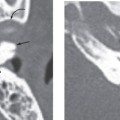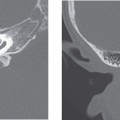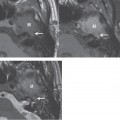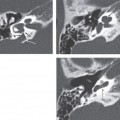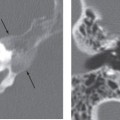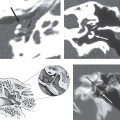CHAPTER 19 Acute Otitis Media and Mastoiditis
Epidemiology
Acute otitis media (AOM) and mastoiditis are infectious processes of the middle ear and a variable portion of the mastoid air cell system. They primarily affect infants and young children. AOM is often preceded by a viral upper respiratory infection that disrupts the mucosal barrier of the nose and nasopharynx, allowing bacteria to adhere and grow. Reflux of infected secretions from the nasopharynx to the eustachian tube allows bacteria to gain entrance to the middle ear.
Clinical Features
Varying degrees of otalgia are usually present, along with fever, sleeplessness, and irritability. Early in the disease process, otoscopy reveals erythema and edema of the tympanic membrane. Fluid rapidly develops in the middle ear, with fluid progressing from serous to purulent. Bulging of the tympanic membrane then occurs with loss of normal bone landmarks. The tympanic membrane may rupture, resulting in decompression of the middle ear and otorrhea. Mastoid tenderness is a common feature. Variable conductive hearing loss may be present.
Pathology
The most common pathogens are Streptococcus pneumoniae, Haemophilus influenzae, and Moraxella catarrhalis. Strains of bacteria resistant to antibiotics have emerged, especially resistant strains of S. pneumoniae.
Pathologic findings consist of mucosal inflammation of the eustachian tube, middle ear, and tympanic membrane. Polymorphonuclear and lymphocytic infiltrates are present along with a mucositis and periostitis. Swelling and thickening of the tympanic membrane occurs and may spread to involve the ear canal. Bone involvement develops if treatment is inadequate.
Treatment
Antibiotics alone are curative in most patients. In uncomplicated cases, myringotomy may be helpful in alleviating pain and quickening resolution of the disease process, whereas it is a critical therapeutic step in the management of complicated cases.
Imaging Findings
CT
Opacification of the middle ear cavity and mastoid air cells with fluid and nonspecific debris is seen in acute uncomplicated otitis and mastoiditis. The integrity of osseous structures, including the ossicles, mastoid cortical bone, and mastoid trabeculae, is preserved.
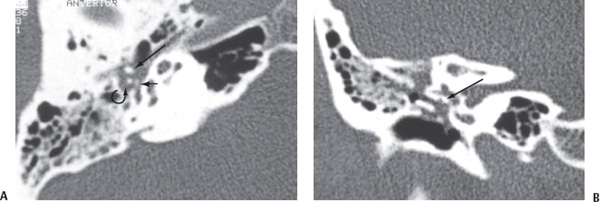
Figure 19-1 Acute otitis media associated with facial nerve palsy. (A) Axial computed tomography (CT) demonstrates mucosal thickening involving the middle ear cavity. The visualized portions of the manubrium of the malleus (long straight arrow), the long process of the incus (curved arrow), and the stapes (short straight arrow
Stay updated, free articles. Join our Telegram channel

Full access? Get Clinical Tree


